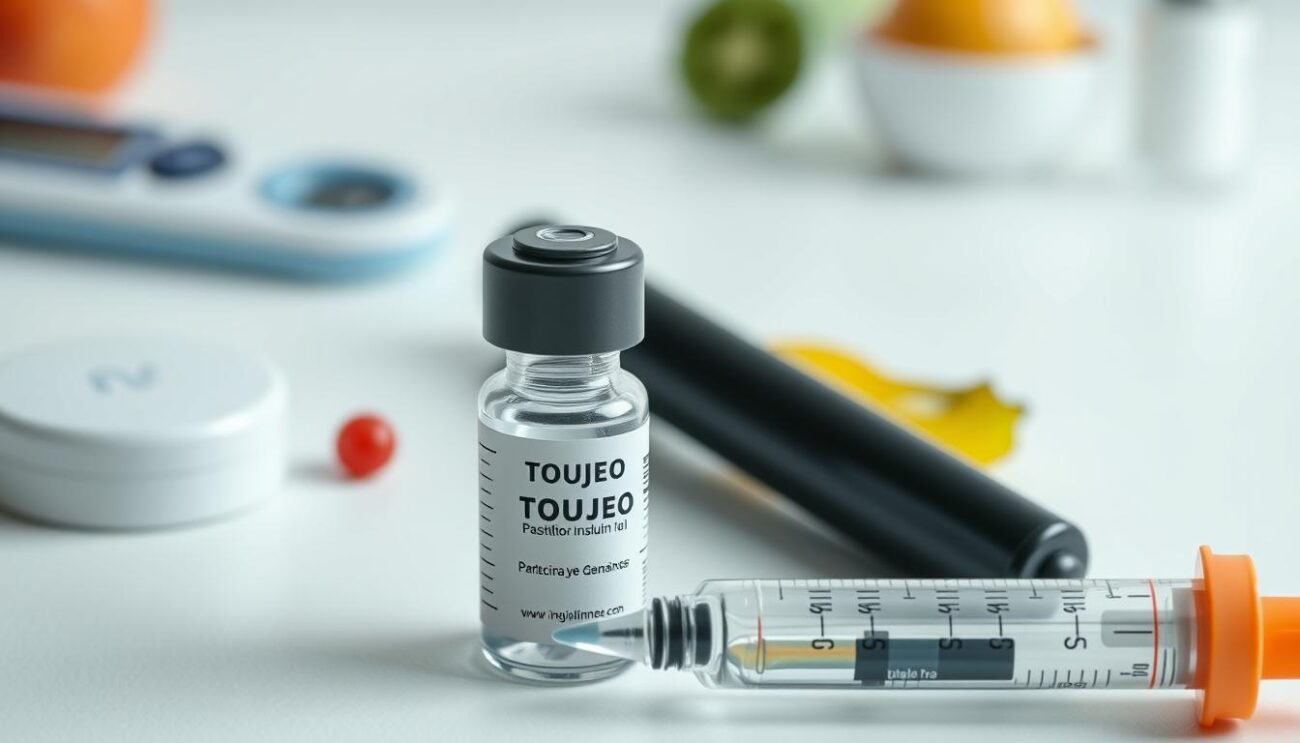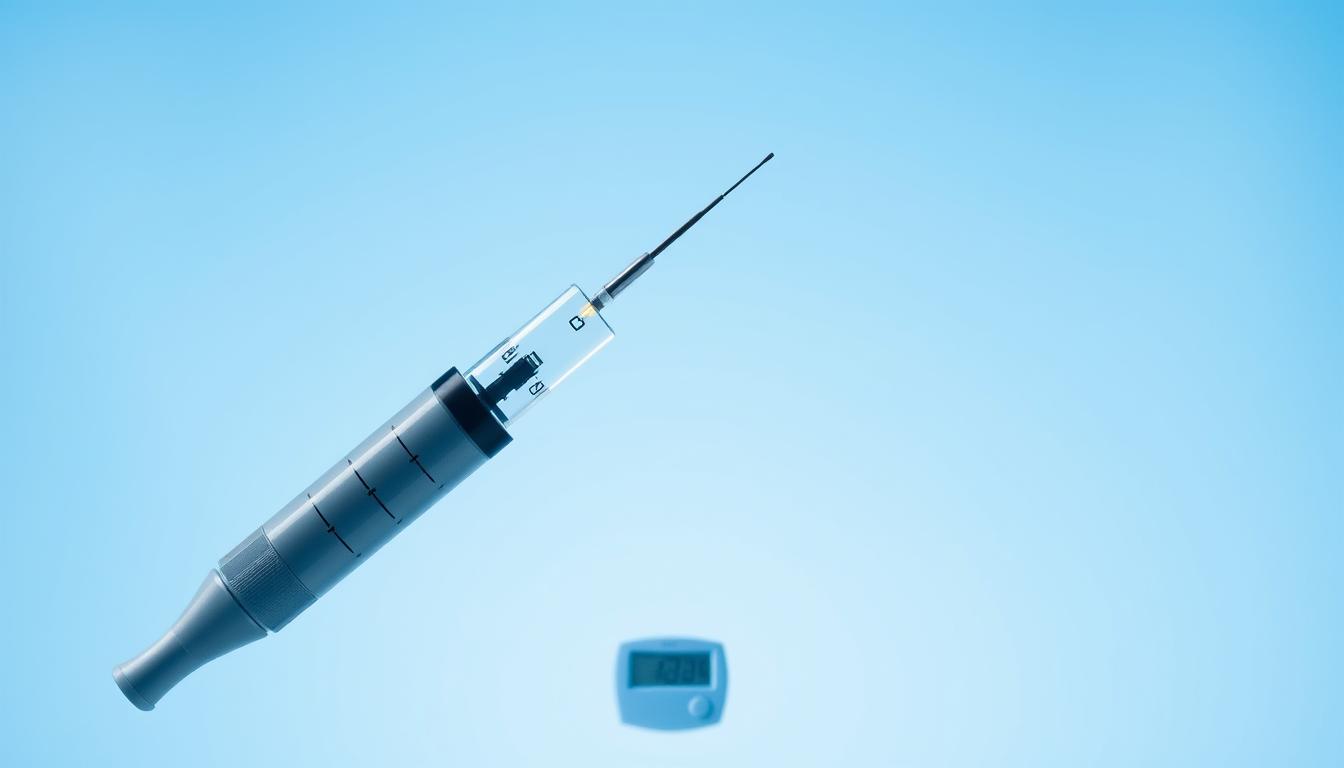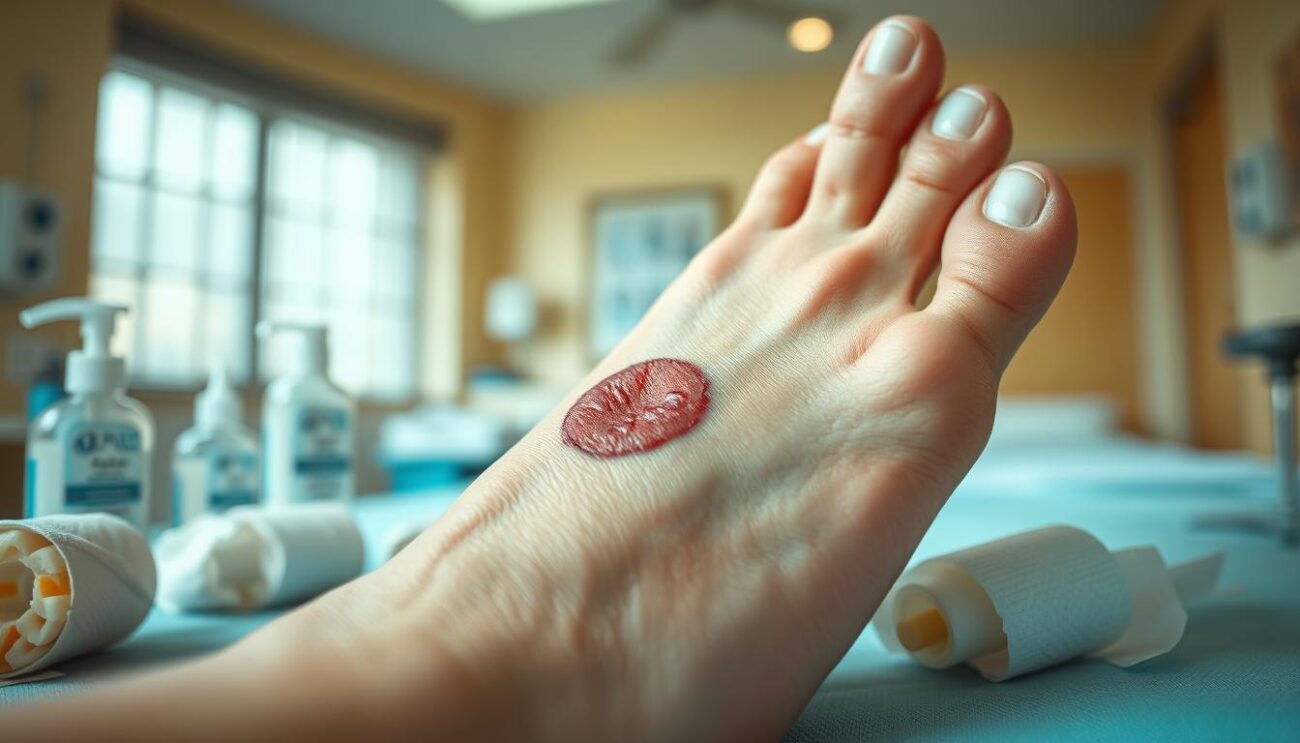Are you having trouble managing your diabetes and thinking about using Toujeo, a long-acting insulin? Knowing the right dosage of Toujeo is key to keeping your blood sugar in check. This guide will help you understand how to use Toujeo for both type 1 and type 2 diabetes.
Key Takeaways
- Toujeo is a highly concentrated long-acting insulin approved by the FDA to manage blood sugar in adults and children with type 1 or type 2 diabetes.
- The recommended starting dose of Toujeo for insulin-naïve patients with type 2 diabetes is 0.2 units per kilogram of body weight once daily.
- Toujeo is available in two pen formulations: the Toujeo SoloStar and the Toujeo Max SoloStar, each with different injection strengths.
- Proper dosage and administration of Toujeo are crucial to achieve optimal blood sugar control and minimize the risk of severe hypoglycemia.
- Factors such as age, kidney and liver function, and prior insulin use can influence the appropriate Toujeo dosage for each individual.
Introduction to Toujeo Insulin
Toujeo is a long-acting basal insulin for adults and kids 6 and up with diabetes. It has 300 units per mL, more than Lantus. This makes it a unique insulin glargine.
What is Toujeo?
Toujeo is a long-acting insulin for diabetes management. It offers 24-hour insulin coverage. This helps control fasting blood sugar.
It’s a once-daily subcutaneous injection. You should inject it at the same time every day.
Indications for Toujeo Use
Toujeo is for diabetes mellitus in adults and kids 6 and older. It’s not for diabetic ketoacidosis. It’s for long-term insulin treatment to manage blood sugar.
The Toujeo insulin gives 24-hour insulin coverage. It’s good for both type 1 diabetes and type 2 diabetes. Its unique concentration and delivery system help patients needing higher doses or precise adjustments.
“Toujeo is a valuable tool in the management of diabetes, providing long-acting insulin coverage to help patients achieve their glycemic goals.”
Forms and Strengths of Toujeo
Toujeo is an insulin glargine solution. It comes in two types of single-use, prefilled pens. These are the Toujeo SoloStar and the Toujeo Max SoloStar. They make it easy and precise for patients to take their basal insulin.
Toujeo SoloStar and Toujeo Max SoloStar Pens
The Toujeo SoloStar pen holds 450 units of Toujeo in 1.5 mL of solution. It can give up to 80 units per injection. The Toujeo Max SoloStar pen has 900 units of Toujeo in 3 mL of solution. It can give up to 160 units per injection.
The Toujeo Max SoloStar pen is best for those needing at least 20 units of basal insulin daily.
- Toujeo SoloStar: 450 units in 1.5 mL, delivers up to 80 units per injection
- Toujeo Max SoloStar: 900 units in 3 mL, delivers up to 160 units per injection
Both pens make it easy and accurate to take toujeo insulin. They help manage diabetes. The different toujeo dosage forms and toujeo insulin strengths help patients find the right toujeo pen for them.
“Toujeo is for adults and children who are 6 years of age and older with diabetes mellitus. Toujeo is not safe for children under 6 years of age.”
Typical Toujeo Dosage
When it comes to Toujeo dosage, the starting point is based on the patient’s prior insulin treatment. For type 1 diabetes, the initial dose is one-third to one-half of the total daily insulin. This is usually around 0.2 to 0.4 units/kg. For type 2 diabetes, the starting dose is 0.2 units/kg once daily.
Dosage for Type 1 Diabetes
Patients with type 1 diabetes often need a higher insulin glargine dosage. The starting dose of Toujeo for type 1 diabetes is 0.2 to 0.4 units/kg of body weight. This is one-third to one-half of the total daily insulin dose. The dosage is then adjusted based on the individual’s response and ongoing glucose monitoring.
Dosage for Type 2 Diabetes
- For patients with type 2 diabetes, the recommended starting toujeo dosage is 0.2 units/kg once daily.
- This initial dose may need to be higher than the previous basal insulin, such as Lantus, to achieve similar glycemic control.
- Careful monitoring and titration of the diabetes medication dosing is crucial to ensure optimal blood sugar management.
Regardless of the type of diabetes, the Toujeo dosage may need to be adjusted over time. This is because the progression of the disease can impact insulin requirements.
“Toujeo dosages may need to be higher than Lantus to achieve similar glycemic control.”
Dosage Toujeo: Understanding Insulin Glargine Use
Toujeo is a medication for once-daily use. It’s given by injection under the skin, at any time of day. The maximum dose is 80 units for the SoloStar pen and 160 units for the Max SoloStar pen. Adjustments in dosage may be needed based on age, weight, activity level, and other health factors.
Getting the right dose of toujeo insulin is key to managing diabetes. The dosage toujeo should match the individual’s health needs. It’s important to regularly check in with healthcare providers to adjust the toujeo insulin dosing as needed.
Missing a dose of insulin glargine dosing can cause high blood sugar. If a dose is missed, take it within 2 hours. But don’t double up if it’s been longer. Taking too much insulin glargine dosing can lead to low blood sugar, which is dangerous.
“Factors determining the dosage of long-acting insulin include weight, type of diabetes, activity level, other medications for diabetes, and specific situations like illness, stress, weather changes, exercise, medication changes, menopause, pregnancy, growth period (in children and young people), fasting periods, and changes in daily routine.”
It’s important to know the side effects of toujeo insulin. These include low blood sugar, allergic reactions, swelling, weight gain, low potassium, and reactions at the injection site. Talking regularly with healthcare providers can help manage these risks and ensure the right toujeo insulin dosing is maintained.

To make toujeo insulin more affordable, patients may be eligible for savings programs. These programs can help reduce the cost of medication significantly.
Switching to Toujeo from Other Insulins
When switching to Toujeo from other basal insulins, start with about 80% of your old dose. It’s important to watch your blood sugar closely during this time. This helps avoid too low or too high blood sugar levels.
Switching from Lantus to Toujeo
Switching from Lantus to Toujeo means your dose might need to be 10-18% higher in adults. For kids, it’s about 8% higher. This change needs careful adjustments and regular blood sugar checks to make the switch safe and effective.
Switching from Other Basal Insulins to Toujeo
For those moving from NPH, insulin detemir, or insulin glargine U-100 to Toujeo, start with 80% of your old dose. Keep a close eye on your blood sugar and adjust your dose as needed. This helps keep your sugar levels stable.
Managing insulin changes is key to keeping your blood sugar in check. It also helps avoid bad side effects. Your healthcare team should guide you through this transition to ensure it goes smoothly and safely.
Special Populations and Dosage Adjustments
When using Toujeo, healthcare providers must think about special populations. They need to adjust dosages carefully. This ensures diabetes is managed safely and effectively in these groups.
Elderly Patients
Elderly patients can use Toujeo, but with caution. The starting dose, increases, and final dose should be gentle. This helps avoid toujeo dosage elderly hypoglycemic reactions. These are more common in older adults due to changes in insulin sensitivity and health.
Renal and Hepatic Impairment
Toujeo is also okay for patients with toujeo dosage renal impairment or toujeo dosage hepatic impairment. But, they need close glucose monitoring and dose tweaks. Kidney or liver issues can change how insulin is broken down and cleared. So, healthcare providers must watch how patients react to Toujeo and adjust doses as needed.
| Special Population | Dosage Consideration |
|---|---|
| Elderly Patients | Conservative initial dosing, dose increments, and maintenance dosage to avoid hypoglycemic reactions |
| Renal Impairment | Close glucose monitoring and dose adjustments may be necessary |
| Hepatic Impairment | Close glucose monitoring and dose adjustments may be necessary |
Understanding Toujeo’s use in special populations helps healthcare providers manage diabetes better. It also reduces the risk of bad side effects.
Administration and Storage of Toujeo
Proper use and storage of Toujeo insulin are key for managing diabetes well. It’s given as a subcutaneous injection. You can inject it in the abdomen, deltoid, or thigh. It’s important to change where you inject to avoid problems.
The Toujeo pens, like SoloStar and Max SoloStar, need to be kept at room temperature. They should be used within 28 days after opening. Never draw the insulin into a syringe. This can cause errors and harm.
Toujeo Injection Instructions
Here’s how to use Toujeo:
- Change the injection site with each dose to avoid lipodystrophy and amyloidosis.
- Do a safety test before each injection to make sure the pen works right.
- Adjust the dose in 1 or 2 unit increments, depending on the pen, to control blood sugar.
- Inject the insulin under the skin to avoid complications.
- Properly handle and dispose of used needles to prevent disease transmission.
Toujeo Pen Use and Storage
Keep Toujeo pens at room temperature, below 30°C (86°F). Use them within 28 days after opening. This keeps the insulin effective. Never draw Toujeo into a syringe to avoid errors.
In summary, using and storing Toujeo insulin correctly is vital for managing diabetes. By following the toujeo injection instructions, using the toujeo pen right, and storing it as directed, patients can use this medication effectively. This helps them reach their blood sugar goals.
Precautions and Warnings for Toujeo Use
When using Toujeo (insulin glargine), it’s crucial to be aware of the potential risks and take necessary precautions. One of the primary concerns is the hypoglycemia risk associated with this long-acting insulin. Patients must be instructed to closely monitor their blood sugar levels and adjust their Toujeo dosage accordingly to avoid life-threatening low blood sugar episodes.
Proper injection site rotation is also essential. Repeated injections into areas of lipodystrophy or amyloidosis may result in hyperglycemia, while sudden changes in the injection site can lead to hypoglycemia. Patients should be advised to rotate injection sites to unaffected areas to ensure consistent insulin absorption and maintain stable blood sugar levels.
Additionally, patients should be reminded to always verify the insulin label before each injection to prevent accidental mix-ups or dilution, which can further increase the risk of hypoglycemia. Maintaining a consistent dosing schedule and following the healthcare provider’s instructions are crucial for the safe and effective use of Toujeo.
“Proper injection site rotation is essential to ensure consistent insulin absorption and maintain stable blood sugar levels.”
By understanding these Toujeo precautions and adhering to the recommended guidelines, patients can maximize the benefits of this insulin while minimizing the potential risks associated with its use.
Conclusion
Toujeo insulin is a long-acting basal insulin. It has shown better blood sugar control and less risk of low blood sugar. The right dose of Toujeo depends on the type of diabetes, past insulin use, and the patient’s health.
It’s important to adjust the dose carefully, change where you inject it, and keep an eye on blood sugar levels. This helps manage the risks of low or high blood sugar with Toujeo.
Studies show that Toujeo helps control blood sugar and lowers the chance of low blood sugar in people with type 1 and type 2 diabetes. Switching to Toujeo from older insulins can lead to better blood sugar control and fewer side effects. But, doctors need to consider each patient’s needs and adjust the dose to get the best results.
In short, Toujeo insulin is a good choice for adults and kids with diabetes. It offers steady blood sugar control for a long time. By knowing how to use Toujeo and manage its dosage, doctors can help their patients manage diabetes better and avoid complications.







